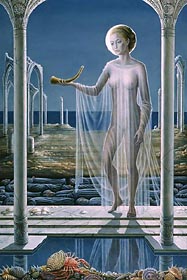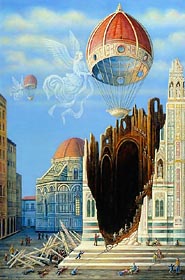
Too
often those of us who write about art fall into obvious traps,
one of them being the tendency to "pigeon hole" an artist
based on but a few highly publicized works. And in many cases,
we miss opportunities to explore the complex development of a
creative persona, and the true meaning of their artwork.
Brigid Marlin
is mainly known as a portrait painter and for her visionary
Fine Art paintings. Beyond that she is an individual
with intense curiosity, a passion for travel and with strong
humanist preferences in her personal work. She has
organizational skills, which she used in founding the
Inscape Group in 1961. This group later was to become the
Society for Art of Imagination, a global entity which
actively promotes fantastic and visionary art through shows
and art projects.
After an extensive formal education in art, she sought out
Prof. Ernst Fuchs. He had researched the technical
developments of the Northern Renaissance, initiated by Hubert
and Jan van Eyck, and later also adopted by a number of painters in
northern Italy. From Fuchs she learned the Mische
Technique, a laborious process of layering tempera with oil
glazes. This method allows a painter to have subtle color and tonal controls and
the ability to render fine details. It can be easily adapted
to either portraiture or to fantasy subjects.

The key to appreciating the originality and diversity of Ms.
Marlin's works is understanding a dualism in her worldview.
Early in life, she learned the value of the ironic, uncanny
and serendipitous experiences that occur in everyday life.
Later she learned through faith that an individual's greatest
achievements are often in accepting one's own humanity, and the
challenges within life itself. Ms. Marlin has been able to
internalize what she observes in our world and incorporate
this into a personal iconography. She has been able to project
her inner vision without the intrusion of arbitrary
subjectivity.
The foundation of Ms.Marlin's art is the Mische Technique.
Her work encompasses a number of differing subjects, ranging
from explorations of inner psyche to fantastic compositions.
In some early works, like
Eater of Dreams (1978)
or The Prisoner (1967), one senses a kinship with the
existentialist trauma in the
Magic Realist paintings of
Jared
French,
Paul Cadmus and
George Tooker from the 1940s. Other
works like Fear of Madness (1966),
Fear at Dusk and
Nightmare (1986)
explore deep Freudian venues.
A second important subject type in Ms. Marlin's work is often referred to as Fantastic Realism, of which there are many
notable examples. The artist has always had a fascination with
Venice, and has included the St. Mark's Cathedral and other
scenes of the city in many of her paintings. She has expanded
the series to include other Italian churchs in fanciful
compositions incorporating balloon shapes, animals and
architectural features. Other paintings such as
Ezekial
(1977),
Clockwork
Leda (1990)
and
The Rod
(1973)
are modern allegories with complex imagery and
meanings open to some interpretation.
referred to as Fantastic Realism, of which there are many
notable examples. The artist has always had a fascination with
Venice, and has included the St. Mark's Cathedral and other
scenes of the city in many of her paintings. She has expanded
the series to include other Italian churchs in fanciful
compositions incorporating balloon shapes, animals and
architectural features. Other paintings such as
Ezekial
(1977),
Clockwork
Leda (1990)
and
The Rod
(1973)
are modern allegories with complex imagery and
meanings open to some interpretation.
Ms. Marlin has been open in explaining that the elements of
these paintings arise spontaneously during the development of
each piece of artwork. In that respect, her creative process
is not unlike the one used by some of the Surrealist painters
of the last century. Salvador Dali once explained that the
idea for melting watches in his painting
The
Persistence of Memory
(1931) came to him while taking a lunch break and eating
camembert cheese.
A third subject type in Ms. Marlin's painting has a more
classical nature. Included are
Rende-vous in Venice
(1984),
Ghost of Spring
(1987),
Undine
(1991) and
Shadow Puppets
(1980). Also, the artist has produced The Mysteries of St.
Dominic series and The Days of the Week series, which includes
Sunday The Sun (1991) and
Monday - The Moon
(1991).
Ms. Marlin has proven herself to be original and adaptive to
many subjects, yet regardless of what she paints, each work
is built on the fundamentals of the Mische
Technique. We invite you to peruse Brigid Marlin's
paintings at Monograffi Fine Art Galleries.
Brigid Marlin's Gallery
Artist's Web Site:
http://www.brigidmarlin.com/
|